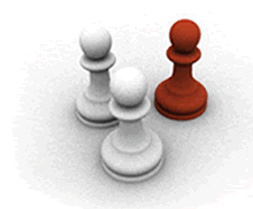|
…or ‘the science of the not-so-simple'.
Have you ever thought that things are just too complicated? That there's too much going on, too many changes, to make sense of everything and work out how to deal with it? Perhaps it's easier to let events take their course and see what happens rather than try to steer the organisation to some sort of common strategic plan that will be outdated before the ink is dry and the document neatly bound for presentation to the Board?
Back in the good old days, markets grew and developed in predictable fashion, competitors did what you expected of them, and your brand's consumers responded by buying more when you increased your share of voice of the only advertising medium that mattered, TV. The Production Director always managed to squeeze that little bit extra cost-efficiency that the MD demanded, and customer service initiatives were the no. 1 priority (although in practice the Sales Department ruled). Strategic Planning meant tweaking last year's document, and learning how to play the budget negotiation game with the Finance Director.
Or something like that.
I think most of us who would say that business is just a little more complicated today. Markets, industries, competitors can change radically and often in unexpected ways, prompting unscripted responses from the other players caught up in these. It's a constantly changing, turbulent landscape - uncertainty abounds. But although the trajectory of an organisation isn't linear – or even parabolic – neither is it purely random.
We are accustomed to thinking ‘in straight lines', in rational steps projecting the future from the present. But things are more complex than that (and indeed probably always were!) – and so we struggle to make sense of it all sometimes.
There is a developing school of thought that might help. Ideas from ‘complexity theory' are being used to help change the way people think about situations. For example, we might not be able to explain why something happened in detail, but there could be some principles or patterns that apply. Looking at a group of organisations in an industry as a system with lots of connections and interactions, with each organisation trying to make sense of what's affecting it and adapting accordingly, gives a different perspective to the traditional market / competition model.
In such a view, an organisation – or a person – reacts to others around it, rather than to some ‘big picture' plan. You can see this in how people behave in an organisation – we all make sense of what a change or message means in the context of our own jobs, teams or departments, and how others respond is a big influence on how we interpret what it means for us. That's why communication isn't just a linear cascade of briefings – it's the informal ‘water cooler' conversations, and the body language and behaviour of others, that determine how people then think, feel and act.
This is a powerful way of thinking about how change happens – in practice rather than in theory – and how strategies are interpreted and implemented across and through an organisation. Complexity theory provides a way of thinking about this, and a language to describe what happens. Sometimes it's helpful to think of organisations as ‘complex adaptive systems', with lots of individual ‘sensemaking' and local reactions going on that determine how the organisation collectively moves forward.
There's a great example to illustrate this of flocking birds – click here to watch - it's well worth a few minutes over a coffee break. How do they keep together and fly as a group? A computer simulation has been created based on three ‘rules of behaviour' – keeping far enough apart from others nearby to avoid crowding or crashes; aligning with the average direction of flight of the birds nearby; and keeping sufficiently close to maintain group cohesion. Some parallels there with how people behave within their teams in an organisation!
I don't profess to have expert knowledge on complexity theory – it's something I'm just beginning to explore. But what strikes me is that there seems to be some useful perspectives that will help describe and perhaps explain what happens in organisations (and markets) in practice, and how they adapt to a complex and changing environment. It's another way of thinking that could help at times – if only to appreciate that nothing's simple! |




